Immigrants, Accidents and Lawsuit Loans: Does NY Need New Rules?
January 30, 2025
Immigrants, Accidents and Lawsuit Loans: Does NY Need New Rules?
January 30, 2025A New York construction laborer, photographed by a jobsite video, is taken to an ambulance following a fall that contractors and an insurer suggest was a staged accident.
Photos supplied by contractors and insurer
It took eight months after construction worker Javier Bances Carranza injured himself in a fall for his lawyer to try to make him feel supported, but it was too late. When the lawyer learned Carranza intended to switch his negligence lawsuit against his employer to a more attentive law firm, according to Carranza’s affidavit, his current law firm texted him asking for explanations and threatened to “damage” his case. “I refused them and blocked their phone numbers,” he said.
A few days later, Carranza stated, one of the lawyer's paralegals came to his Bronx home, insisting he return and “she also offered me loans for $40,000 and then for $50,000, which I rejected.”
Exactly how the loan Carranza turned down was to be made isn’t clear—lawsuit loans are allowed in New York, as long they are not made by an attorney. Yet Carranza’s story, told in his native Spanish and translated into English, is a potent clue to the value of his claim and the thriving business of bankrolled lawsuits.
With its plaintiff-friendly state law that makes employers 100% negligent for many fall-related injuries, New York State courtrooms are always filled with personal injury cases. In the last decade or so, the caseload has swelled with new plaintiffs and bigger potential payouts. Recent immigrants took over many nonunion construction tasks that other workers didn’t want—chipping away old mortar, sealing leaky roofs—and filed many injury claims. At the same time, juries became more willing than ever to make multiple $10-million-plus damage awards. These awards and the potential for more drove insurers to raise premiums and lower payout limits.
“I went from $300,000 to $2 million a year for liability insurance in the course of two years,” says Steven Katz, chief executive of Kay Waterproofing, a contractor.
To combat a surge in lawsuits and the rising insurance costs, three restoration contractors and insurer Roosevelt Road Re and its affiliate, Tradesman Program Managers, last year filed civil racketeering fraud lawsuits in federal court in New York City. The defendants are two law firms, various medical providers and physicians, and a “runner” who allegedly recruited and groomed numerous undocumented immigrants who did not speak English, orchestrating fake injuries and even having workers undergo unnecessary surgery.
To boost their case, the contractors and insurers have released project cam or surveillance videos of allegedly faked accidents—workers deliberately tumbling in slow-motion, careful not to hurt themselves—that are almost comically audacious. Shown in 2023 for the first time in a report on local television station WABC-7, the videos may bring more attention to the cost of liability insurance in New York than decades of discussing the state labor law and the fruitless efforts to change it.
There is one element of the racketeering lawsuits that has not gotten much attention: lawsuit loans.
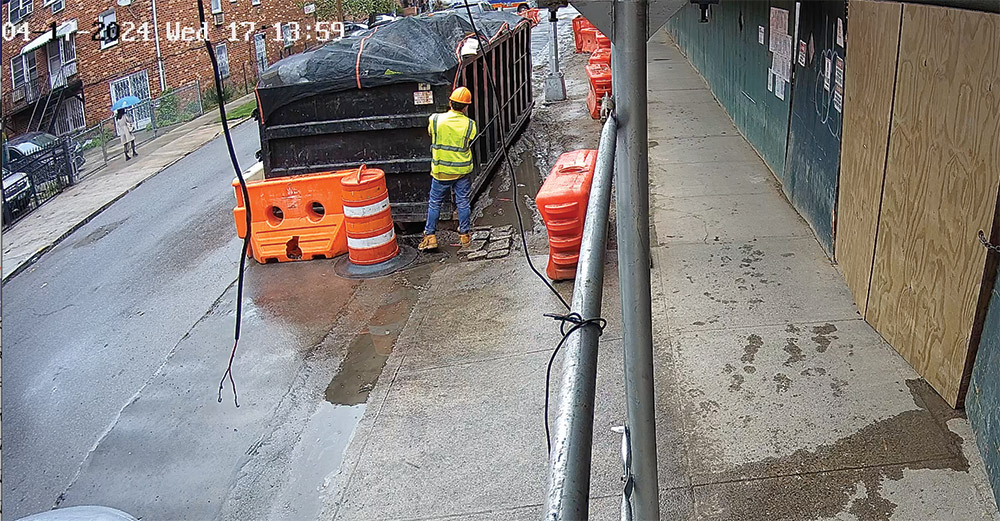
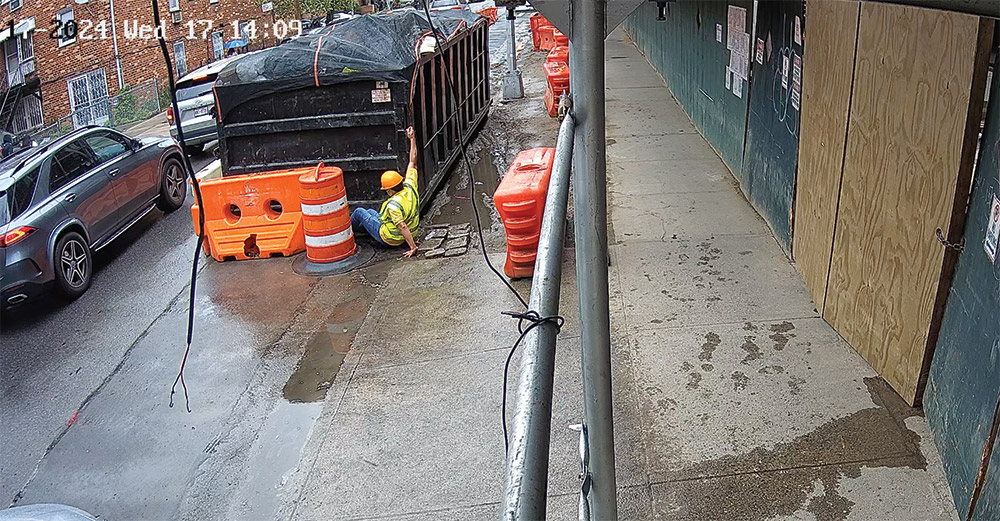
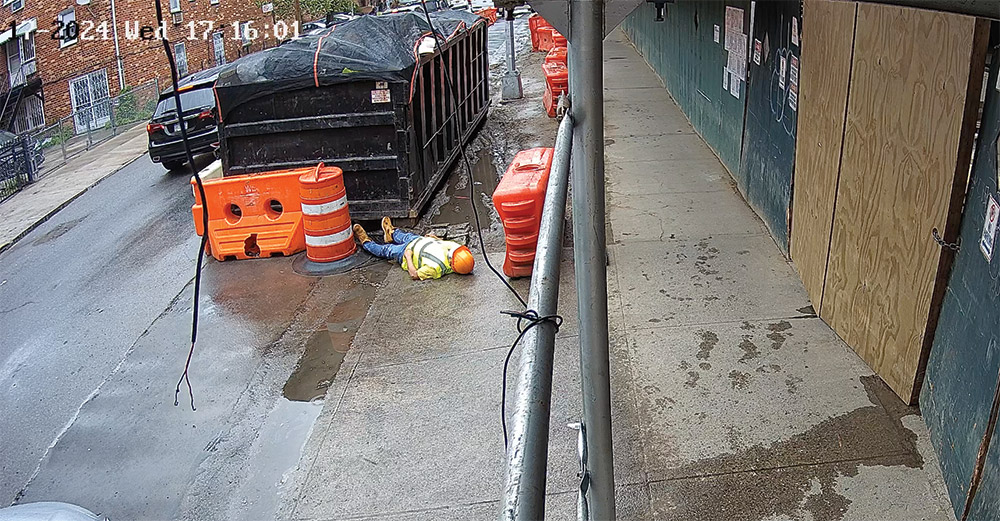
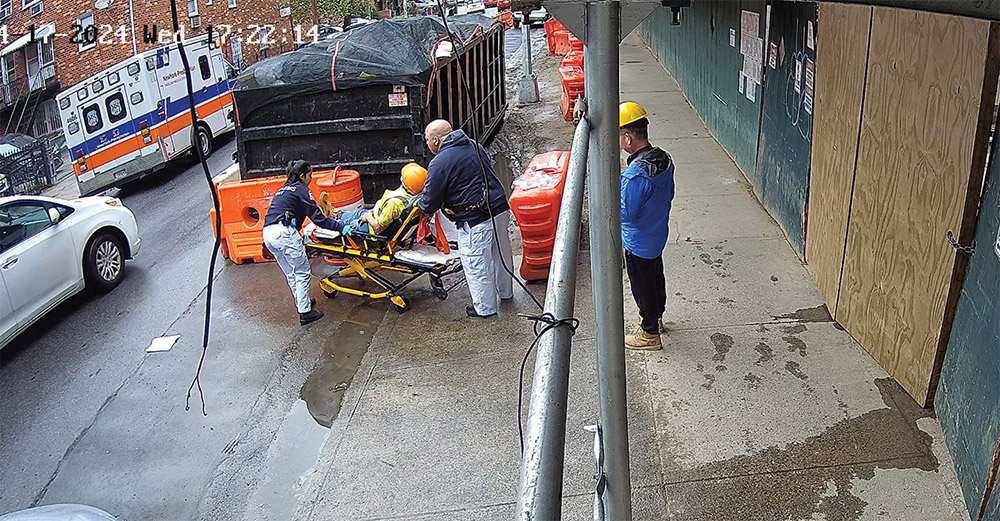
One of several videos released by contractors and an insurer that appears to show a worker first looking around and then gently lowering himself to the ground as though he had fallen before being taken away by EMTs in an ambulance.
Photos supplied by contractors and insurer
Pre-settlement Lenders
The last decade has seen the specialized pre-settlement lawsuit funding business—at one time a field of small local get-cash-fast, high-interest lenders—evolve into a branch of the multibillion-dollar third-party legal funding industry. Finance companies behind the loans are pumping millions of dollars to injured workers for medical treatment or living expenses, and millions more to law firms to pay for long cases. If the case is won, the lenders put a big part of any damage award or settlement in their own pockets.
One of the country’s biggest such lenders, Cartiga, made at least 117 loans of all types to individuals in New York State in 2023, lien records show, and 13 in 2024.
The attorney for the contractors and insurer say the loan issue will soon become more prominent in the crusade against the injury “fraudemic,” as some call it. “We believe third-party litigation funding is an important part of the fraudulent scheme” involving faked and exaggerated injuries, says the attorney, William Clay. Although no funding companies have been named as defendants, he says, “as new cases are filed there will be more insight and emphasis” on the lenders.
Such loans have implications beyond New York. After years of steady growth until 2023, when the numbers levelled off, a litigation funding bull market prevailed. Consultant Westfleet Advisors, which tracks the litigation funding industry, says that about one out of three dollars invested by U.S. litigation lenders in 2023, or about $5 billion, was directed to clients rather than to the law firms, tiding them over with medical and living expenses during the years that many cases take to resolve.
With litigation funding’s rise, insurance broker Gallagher recently noted, there was “concern” over the lack of state-level regulation, exorbitantly high interest rates and “prolonging cases in search of massive awards and influencing attorney-client relationships behind the scenes.” Pre-settlement lawsuit lenders are aware of the ethical issues in their industry and of their image as “lawsuit loan sharks,” in the words of Nova Legal Funding, a lender. The American Legal Finance Association, whose members lend to plaintiffs for living expenses, backs legislation proposed in New York that would address a lack of “sufficient consumer protections for those who need” money to sustain themselves until there is a settlement for their injuries, the association says on its website.
Lawsuit lending encompasses two types of loans: those made to plaintiffs for living and medical expenses and those made to law firms to fund their operations in individual lawsuits. The loans generally are non-recourse, meaning the borrower owes nothing if the court case doesn’t produce a settlement or jury award.
Funding companies choose carefully. Casey Grabenstein co-chairs the litigation funding practice group for attorneys Saul Ewing in Chicago, helping litigation lenders carry out due diligence on loan risk. He says that litigation funding gives small individual plaintiffs and businesses a better chance of prevailing in court, noting that “The need for it has developed in cases of David versus Goliath—it evens the playing field.” New York State Judge Shirley Werner Kornreich had expressed the same idea: it is “sound public policy of making justice accessible to all, regardless of wealth” because the cost of lawsuits can discourage claims against “deep pocketed wrongdoers,” she said.
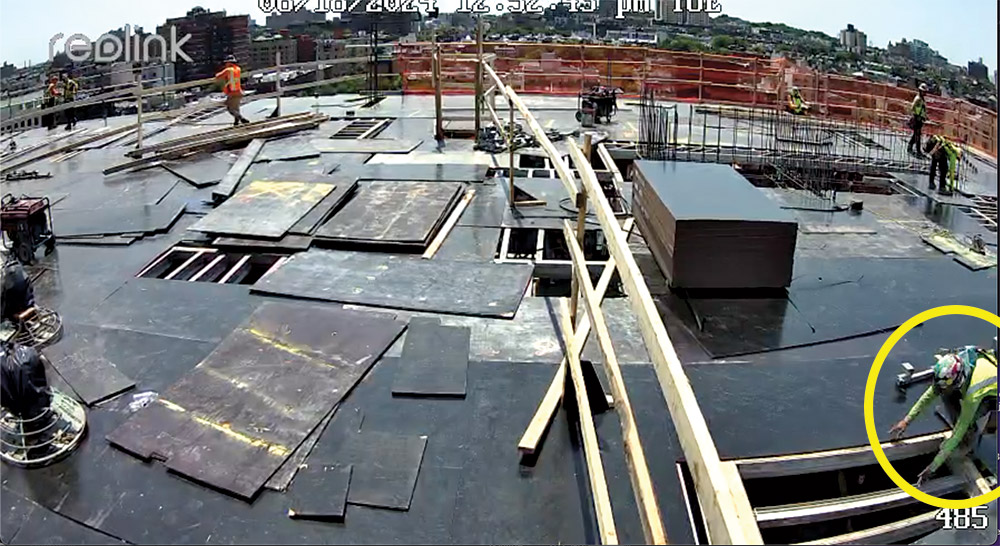
Workers on a New York rooftop are busy doing their jobs while a colleague (lower right hand corner circled) appears to drop himself through an opening in what insurers and employers allege became a faked fall.
Photo: New York State Court Files
Grabenstein’s firm also advises insurers on risks of big damage awards and the potential to limit the risk with litigation risk insurance, a policy that can protect defendants from costly, catastrophic court judgments. While consumers may be aware of litigation-related loans, says Grabenstein, “I really think it’s the legal industry” that is attuned to the need for financing.
To be sure, it’s unrealistic to expect low or modestly paid workers, especially people who are badly injured and out of work, to fund their cases. Even attorneys need money to pour into promising claims. In California, everything from the court pleading filing fees, costs of depositions and transcription and expert witnesses, who may charge $200 all the way up to $800 an hour, “have gone up tremendously,” according to a veteran personal injury practice paralegal. Cases also may go on for years.
New York State has practically no regulation of lawsuit loans, but other states do. Disclosure to defendants that a loan is backing the case is the biggest issue. According to Slipcase, a London-based reinsurance news website, three states—Louisiana, Indiana and West Virginia—recently joined two others in requiring disclosure in some circumstances of third-party legal funding. Nine other states had restrictions proposed in 2024 that failed to pass.
There may be other rules. State regulations sometimes dictate the information lenders must put in their funding contracts, such as the total amount consumers must repay. Some limit the interest rates and fees that funders can charge. Tennessee caps the annual interest rate on a loan at 36%, according to Mustang Litigation Funding.


Defendants’ attorneys sometimes try to determine if an immigrant is working legally by requesting a Social Security number, which is what happened in an injury case involving this roof work in New York City. Plaintiffs’ attorneys generally refuse to provide it.
Photo: New York State Court Files
*Click the document for greater detail
The New York Liability Difference
New York is different in another way. Its employers are 100% negligent under state law for fall-related injuries, even if the worker is partly responsible. Since enactment in 1885, Labor Law 240(1) has survived attacks by business associations and judicial reform advocates who blame it for escalating insurance costs and imposing a hidden tax on every New Yorker by making construction, medical practice and driving costlier.
With personal injury lawyers among the top contributors to members of the New York State Assembly and Senate, Labor Law 240(1) has proven to be an immovable object. Add to that law the easy-to-recruit immigrants, outside case funding and the potential for “nuclear verdicts” of $10 million or more—and the stage is set for insurance costs to climb even higher.
At a press conference about the faked accidents held in the Brooklyn, N.Y., courthouse on Jan. 17, Elizabeth Crowley, CEO of the Building Trades Employers Association, described New York City’s skyrocketing insurance costs: “Since 2010, the cost to insure a $100-million project has tripled, from 4% in 2010 to 8.5% in 2020, and to a staggering 12% in 2024.”
John Kalafatis, co-founder of Skyline Restoration, knows what it is like to be beset by lawsuits. From 1999 to 2013, the company had been a defendant in a state court lawsuit 23 times, according to court records. Since 2014, 130 lawsuits have targeted Skyline, with 23 lawsuits in 2022 alone. Most are personal injury claims.
“We’re trying to get funding disclosed because to us, it’s really important.”
- Alecia Walters-Hinds, Partner, Lewis Brisbois, Attorneys
“Fraudulent claims picked up in the last four years,” Kalafatis says. “Now and then we can deal with them; there are always cases with inflated claims. But suddenly they became the majority of claims and it can’t be explained any other way” than as conspiracy among many partners, he adds. “The New York State labor law doesn’t justify fraudulent claims,” Kalafatis says, yet “smart people” have made them a regular part of the legal machinery.
Insurers have caved in and settled too many lawsuits, Kalafatis says, and pass losses on to customers. He’s also not a fan of local prosecutors that have failed to take an interest in faked injury insurance fraud and has an even more intense resentment against the legal professionals and others who have helped create the current blizzard of lawsuits and rise in insurance rates.
But Kalafatis now feels confident that something can be done. “We luckily found some powerful allies I think together can make a difference, slowly, in this noble fight,” he says, “or otherwise it will decimate an industry.”
A turning point may have been reached in November 2023, with a report on faked construction accidents on the local WABC TV station, which featured the videos and stressed the costs the fraud imposes on insurance and the public. Last spring, the contractors in the TV report and Kalafatis’ captive insurer also filed the first of two civil racketeering fraud lawsuits targeting a law firm and many other defendants. In July, a separate re-insurer and its affiliate, Tradesman, filed a second similar civil fraud racketeering lawsuit in federal court in New York City. Among the defendants were principals of Subin Associates.
Something remarkable then came to light. Subin Associates began seeking to transfer about 175 personal injury cases to other firms, court records show. The company told a judge that there were questions about the source of the lawsuits, an individual who referred many cases to Subin. Another layer of complexity developed: Exo Industries Corp., a contractor that had been the defendant in a personal injury lawsuit brought by Subin Associates, then filed its own complaint against Subin Associates, alleging that the law firm was a key player in bringing faked injury lawsuits against employers. Exo Industries’ attorney, Kenneth B. Danielsen, wanted to force Subin Associates to disclose the identity of the source of the fraudulent lawsuit referrals.
In a hearing last year, Danielsen pressed a skeptical judge, Dakota D. Ramseur, to require Subin to name the source of the lawsuits. The judge had asked Danielsen why the identity of the source is relevant to a labor law case. “You mean a witness says [the accident] didn’t happen?”
Danielsen replied: “This is yet another incident where unwitnessed, [the victim] is thrown in a car by a friend, taken to a hospital, sent to a list of doctors that have been used in virtually every [one] of the other cases I cite in my papers here, and then is brought to the Subin firm by a referral source that nobody has been permitted to know who they are.”
The judge said that the source need not be named to try the case in her courtroom. “We agree on the facts … You might need … an attorney general here.”
“I’m not saying that it’s not fraud,” Ramseur continues. “But I’m saying that this may not be the venue.”
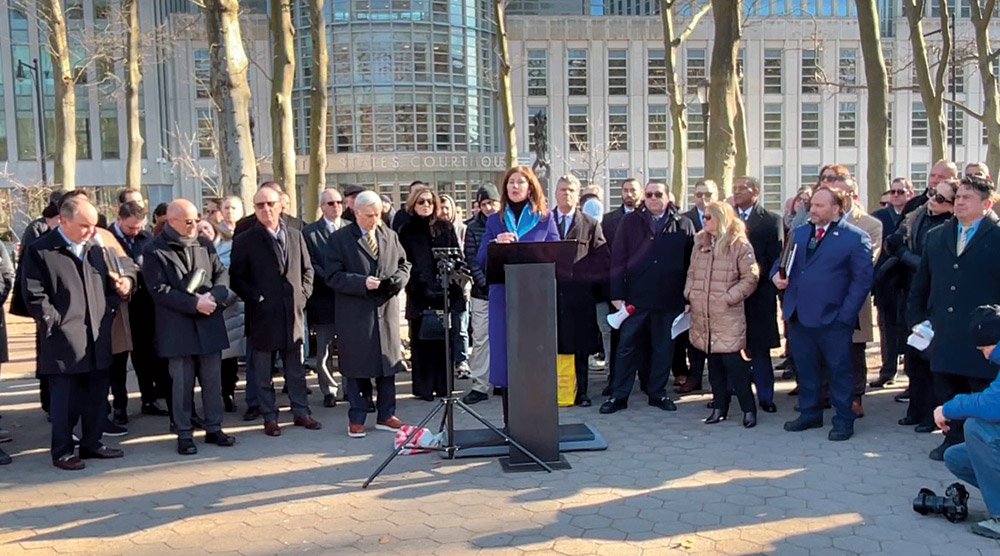
A New York bill that would treat faked construction accidents as felonies failed to pass in 2024 but supporters are hoping state lawmakers bring it to a vote this year.
Supporters of a proposed law to make staged construction accidents a felony in New York State held a press conference.
Photo: Courtesy of Event Organizers
A Subin Associates’ attorney denied that the identity of the case referral source was needed and argued that Danielsen was wrongly impugning Subin Associates’ reputation. The firm did not respond to ENR’s requests for comment, but in response to the insurer’s lawsuit, Subin Associates earlier this month asked a judge to throw it out for failing to state a claim—saying the petition contains “bombastic statements” about industry-wide fraud but fails to support the claim of fraud.
The possibility of fraudulent injury claims has also raised concerns at a funding company. Kristopher D. Hassett, a former Cartiga sales vice president, petitioned a state court in Manhattan to require it to produce documents related to his dismissal in 2023, when the firm cut its workforce by 20%. Cartiga argues that Hassett’s layoff was part of an across-the-board reduction and sales department re-organization.
Hassett claimed his termination was for other reasons. He alleged that he had found that some of the New York Labor Law 240(1) cases that Cartiga had funded could be based on fraudulent claims.
According to Hassett’s petition, he was “a lead” of Cartiga’s claim division responsible for funding and supporting claims brought under the New York law. After reviewing risks, he believed the company had funded fraudulent claims—and he notified several senior managers. Hassett claims that one instructed him to keep the cases “on the books” to maintain volume.
Later, Hassett alleges, an individual associated with a partner law firm was identified—only a first name is used—as the referral source for the cases and a person who “creates cases.” In one conversation with a Cartiga manager, Hassett further alleges, he was told that labor law cases were sometimes “hairy” and that the company accepted a certain level of fraud risk.
No further corroboration of the charges exists, and a state court judge threw out Hassett’s petition, describing it as a “fishing expedition” for evidence. The case is not finished yet, however, and an attorney for Cartiga, Kiren Choudhry, declined to comment because the litigation was continuing.
Seeking Loan, Immigration Data
Some attorneys who defend against personal injury cases that are not settled immediately in New York have been looking for ways to discover the plaintiff’s immigration status and employ it in their defenses. The information can be used to justify a lower amount if lost earnings are involved or just portray the plaintiff as someone who doesn’t play by the rules.
For example, the defense attorney sometimes asks for the defendant’s Social Security number. If he or she has none, that likely means that the plaintiff is an undocumented immigrant or lacks permission to work in the U.S. The plaintiff’s attorney usually instructs his or her client not to respond. The defense attorney may then resort to another line of questioning about how the worker came to the U.S. When that happened during a deposition in a case brought by Edison Fernando Pesantez Ramon, who says he fell and injured himself on a staircase at a building renovation in 2021, the worker's lawyer refused, saying that the state court of appeals has ruled that undocumented workers are eligible for workers’ compensation payments and are entitled to recover the cost of medical care and lost wages due to negligence.
“We refuse to subject our client to be intimidated or harassed by defendants based on his immigration status while the defendants reaped the benefits of our client’s work,” wrote his attorney, James W. Coscia.
Defense attorneys also want to know if there is a lawsuit loan backing a case, but as of now, they are not entitled to find that out in New York. Along with a handful of other states, New York does allow public viewing of lien records that may have been filed by a lender against any settlement or damage award to a plaintiff.
“We’re trying to get funding disclosed [in court cases] because to us, it’s really important,” said Alecia Walters-Hinds, a partner at law firm Lewis Brisbois, during a recent webinar on nuclear verdicts and lawsuit funding. “Anything that’s material or relevant to the lawsuit should be disclosed,” she said.
Why is it important? “There has been unnecessary treatment and surgery,” she added. “It’s a hot topic in New York, because a lot of it has to do with fraud.”
Lawsuit loans also raise the issue of questionable relationships between the lender and the plaintiff’s attorney. “More and more defense firms like us have been able to find a relationship between the litigation funding company and the plaintiffs’ attorney,” Walters-Hinds said. “A plaintiffs’ attorney will ask: Do you want $75,000 or $150,000? … and that involves having unnecessary surgeries.”
Last year, New York legislators proposed a law to make faked or staged construction accidents a felony. Supporters hope to advance it in 2025.
Meanwhile, as Cartiga’s website notes, “legislatures, courts and society recognize” litigation funding as “mutually beneficial contracts between investors and plaintiffs.” It adds: “The trend toward normalizing litigation finance continues.”
Additional reporting by Jonathan Barnes










